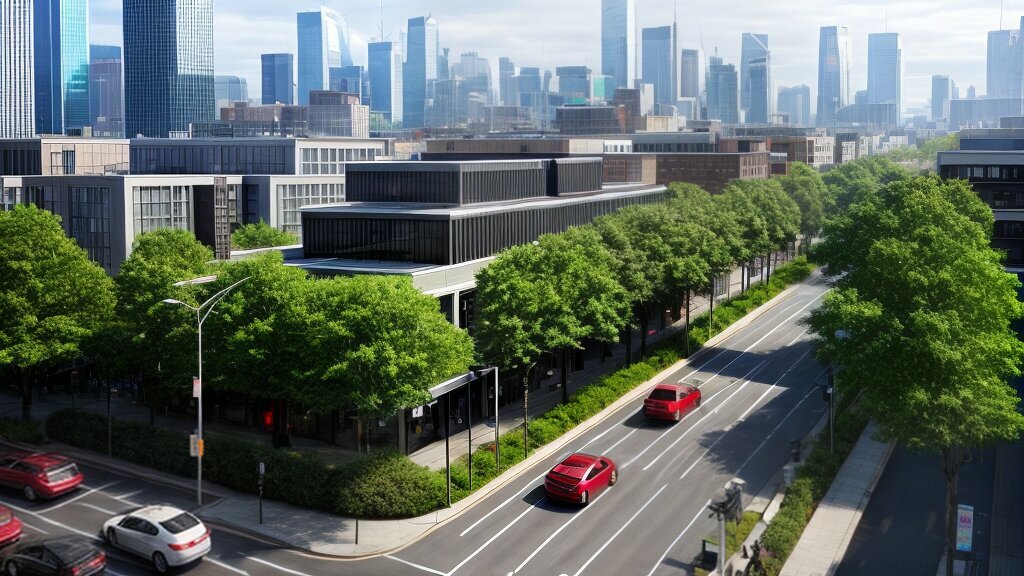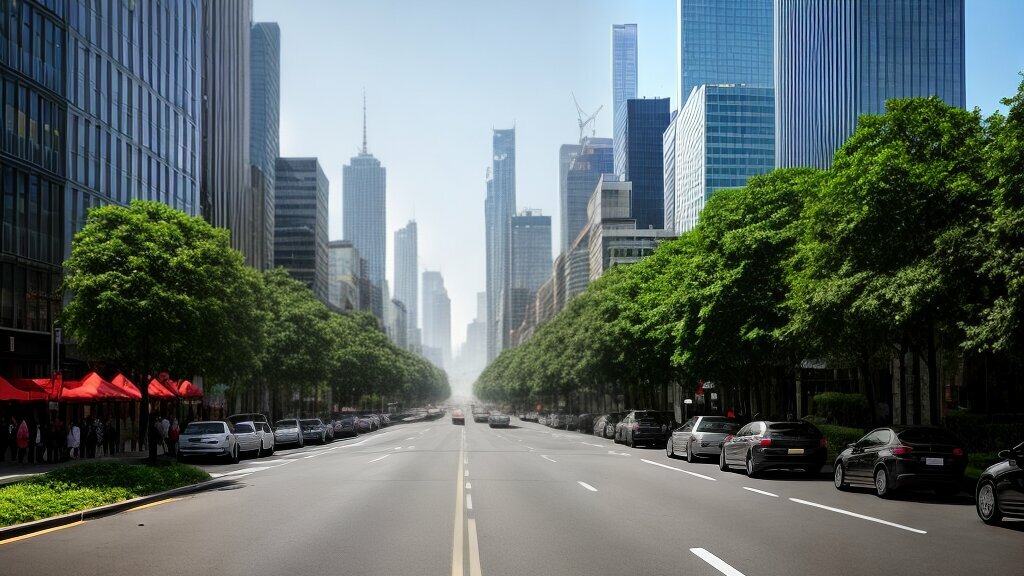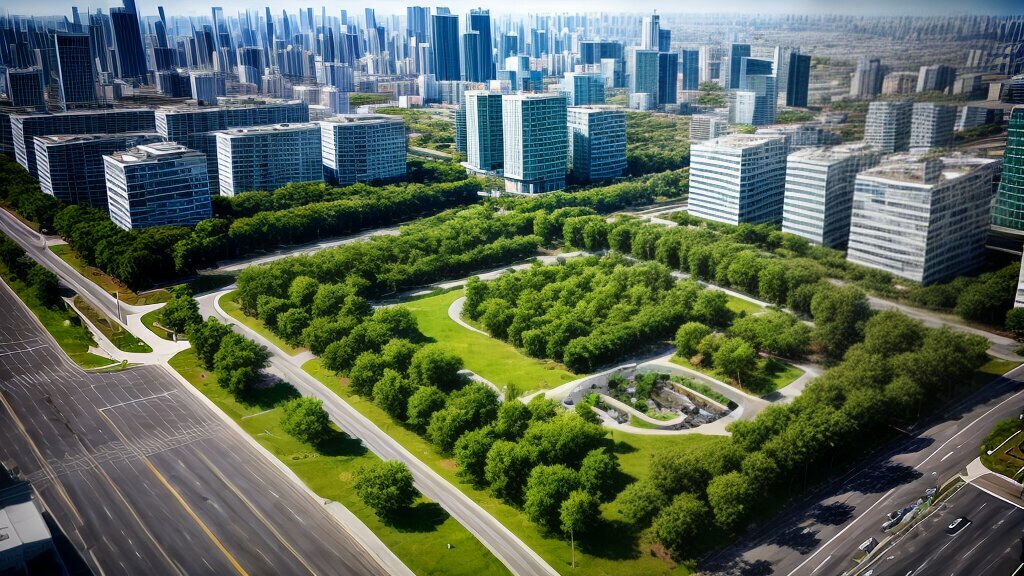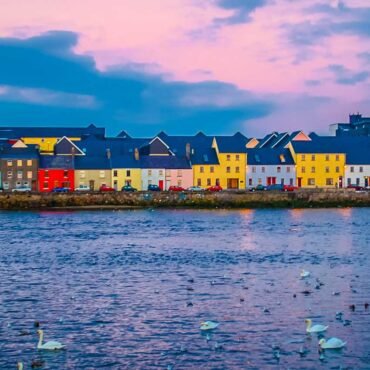Welcome to our article on the importance of eco-friendly cities and sustainable urban planning. As our population continues to grow and cities become more densely populated, it is essential to create communities that promote a sustainable way of life. Eco-friendly cities are designed with the environment in mind, focusing on reducing carbon emissions, preserving natural resources, and improving the quality of life for residents.
Urban planning plays a significant role in creating sustainable communities. By incorporating green infrastructure, renewable energy sources, effective waste management strategies, and eco-conscious transportation, urban planners can design cities that are not only environmentally friendly but also economically and socially sustainable.
Key Takeaways
- Eco-friendly cities prioritize sustainability and reducing environmental impact
- Urban planning plays a vital role in creating sustainable communities
- Green infrastructure, renewable energy, waste management, eco-conscious transportation, green architecture, urban gardening, and biodiversity conservation are essential components of eco-friendly cities
Green Infrastructure: Building the Foundation for Sustainability
Green infrastructure is a fundamental component of eco-friendly cities. It involves the integration of natural elements, such as parks, gardens, and trees, into urban landscapes. By incorporating green spaces into cities, we can improve air and water quality, provide habitats for wildlife, and promote sustainable living.
A study conducted by the University of Exeter found that people living near green spaces reported lower levels of mental distress and higher levels of life satisfaction compared to those living in urban areas without access to green spaces. Furthermore, green spaces can also provide opportunities for leisure and physical activity, which can improve overall health and wellbeing.
| Benefits of Green Infrastructure: |
Examples of Implementation: |
| Improves air and water quality |
Implementation of rain gardens and green roofs in Chicago, USA |
| Provides habitats for wildlife |
Creation of green corridors in Copenhagen, Denmark |
| Promotes sustainable living |
Integration of urban forestry in Singapore |
Incorporating green infrastructure into urban planning can be a challenge, but it is crucial for creating sustainable and liveable cities. Governments and city planners need to work together to ensure that green spaces are integrated into urban designs and that they are accessible to all residents.

Green Infrastructure: Building the Foundation for Sustainability.
“Green infrastructure is an investment in the future health and well-being of urban residents. By incorporating natural elements into cities, we can create a more sustainable and liveable environment for generations to come.”
- Green spaces can promote mental and physical wellbeing
- Green infrastructure can improve air and water quality, provide habitats for wildlife, and promote sustainable living
- Governments and city planners need to work together to ensure that green spaces are integrated into urban designs and that they are accessible to all residents
Powering the Future: Renewable Energy in Eco-Friendly Cities
In the transition towards sustainable living, the use of renewable energy sources is crucial. Eco-friendly cities have been at the forefront of this movement, implementing innovative and successful renewable energy strategies.
Solar power: One of the most notable examples of renewable energy implementation in eco-friendly cities is the use of solar power. Many cities have installed solar panels on public buildings and homes, reducing reliance on non-renewable energy sources. For instance, the City of Sydney in Australia has set a target of reaching 100% renewable energy by 2030 and has already installed over 3,500 solar panels on buildings throughout the city.
Wind power: Another promising renewable energy option is wind power. Cities such as Copenhagen have embraced wind energy, with over 100 turbines installed in the city to provide electricity for over 100,000 households. Additionally, offshore wind farms have been established in many coastal cities, providing a sustainable source of energy.
Hydro power: Hydro power, which utilizes the power of water to generate electricity, is another renewable energy option. Cities such as Vancouver have implemented hydro power systems to reduce their carbon footprint.
These renewable energy sources have numerous benefits, including the reduction of greenhouse gas emissions, improved air quality, and the creation of local jobs. As renewable energy technology advances, it will become increasingly accessible and affordable for all cities to transition towards sustainable energy sources.

“We have to find ways to shift towards renewable energy sources if we want to protect our planet for future generations.”
Waste Management: Reducing, Reusing, and Recycling
Effective waste management strategies are critical to promoting sustainability in eco-friendly cities. By reducing, reusing, and recycling waste, we can significantly reduce the amount of material sent to landfills and promote a circular economy.
One example of successful waste management implementation is the city of San Francisco, which has achieved an impressive 80% waste diversion rate through a combination of source reduction, recycling, and composting. The city’s mandatory recycling and composting laws have been instrumental in achieving this goal, and residents are now required to separate their waste into three bins: compost, recycling, and landfill.
Composting is an essential component of sustainable waste management as it diverts organic waste from landfills and reduces greenhouse gas emissions. In addition, compost can be used as a natural fertilizer, promoting plant growth and soil health.
Innovative approaches to waste reduction are also emerging, such as the zero-waste movement, which aims to eliminate waste entirely through the redesign of products, packaging, and systems. This approach requires a collaborative effort from individuals, businesses, and governments, but the benefits of a zero-waste society are significant, including reduced environmental impact, increased resource efficiency, and a healthier planet for future generations.

Implementing effective waste management strategies requires a shift in attitudes towards consumption and waste. By prioritizing the reduction, reuse, and recycling of materials, we can create sustainable cities that promote a circular economy and minimize our impact on the environment.
Moving Towards a Greener Future: Eco-Conscious Transportation
Eco-conscious transportation plays a crucial role in creating sustainable, eco-friendly cities, by reducing carbon emissions, traffic congestion, and air pollution. By promoting environmentally friendly modes of transportation, cities can create a healthier living environment for their residents, while also reducing their carbon footprint.
One way to achieve this is by promoting public transportation. Cities can invest in efficient, low-emission public transit, and incentivize its use through subsidies and discounts. This not only reduces congestion on the roads but also provides affordable, accessible transportation for all residents, especially those who can’t afford to own a car.
Cycling infrastructure is also an important aspect of eco-conscious transportation. Cities can invest in bike lanes, secure bike parking, and bike-sharing programs, to encourage residents to cycle more instead of driving. This promotes physical activity, reduces traffic, and creates a cleaner environment for everyone.
Electric vehicles (EVs) are another sustainable alternative to traditional cars. Many cities are now offering incentives such as tax credits and free charging stations to make EVs more accessible and affordable for residents. This promotes the shift towards a cleaner, more efficient transportation system that reduces our dependence on fossil fuels.

“Investing in eco-conscious transportation is a win-win for both the environment and our quality of life. By reducing pollution and promoting sustainable modes of transportation, we can create a healthier and more vibrant city for all residents.”
Building for the Future: Green Design in Urban Architecture
As cities expand, it is essential to consider the long-term impact of urban development on the environment. Green design in urban architecture is an approach that promotes sustainable building practices and reduces our carbon footprint. By incorporating eco-friendly materials and technologies into buildings, we can create more energy-efficient structures that not only benefit the environment but also improve quality of life for residents.
Green Building Materials
One way to implement green design in urban architecture is through the use of sustainable building materials. Materials such as bamboo, recycled glass, and reclaimed wood are eco-friendly alternatives to traditional building materials that are often sourced from non-renewable resources. These materials are not only better for the environment, but they also add a unique character to urban architecture.
| Sustainable Building Materials: |
Advantages: |
| Bamboo |
Fast-growing and renewable, durable and strong |
| Recycled Glass |
Non-toxic, saves energy, reduces waste in landfills |
| Reclaimed Wood |
Reduces the need for timber harvesting, reduces waste |
Energy-Efficient Design
Another way to incorporate green design in urban architecture is through energy-efficient building design. This can include the implementation of features such as solar panels, green roofs, and rainwater harvesting systems. These features not only reduce a building’s carbon footprint but can also save residents money on energy bills.

Green Technology Integration
The integration of green technology, such as smart building systems and energy-efficient appliances, can also help to reduce a building’s environmental impact. Smart building systems, for example, can automatically adjust temperature and lighting to optimize energy usage based on occupancy, while energy-efficient appliances can significantly reduce energy consumption compared to conventional appliances.
By prioritizing green design in urban architecture, we can move towards a more sustainable future and create cities that are both environmentally and economically resilient.
Cultivating Nature in the Concrete Jungle: Urban Gardening
Urban gardening is gaining momentum as a sustainable way to promote biodiversity, enhance air quality, and provide food security in eco-friendly cities. Community gardens, green rooftops, and vertical gardens are just some of the ways urban gardening is transforming the concrete jungle into an oasis of greenery.
Community gardens are community-managed open spaces that are accessible to anyone who wants to grow fruits, vegetables, or flowers. These gardens provide a range of benefits, including promoting social cohesion, enhancing biodiversity, and improving food security. They are a great way for local residents to connect with nature and each other, while also reducing their carbon footprint.
Green rooftops are an innovative way to bring nature into urban areas. They involve planting vegetation on rooftops, which helps to reduce the urban heat island effect and improve air quality. Green roofs are also great for capturing rainwater and reducing stormwater runoff, which can help to prevent flooding.

Vertical gardens, also known as living walls, are becoming popular in urban areas where space is limited. These gardens are created by affixing plants to a vertical surface, such as a wall or a fence. They are an excellent way to increase green space in urban areas, reduce the urban heat island effect, and enhance air quality. Additionally, they provide insulation, which can help to reduce energy consumption in buildings.
Urban gardening is not only beneficial for the environment, but it also contributes to the well-being of urban residents. Studies have shown that spending time in green spaces can improve mental health, reduce stress, and enhance cognitive function. By promoting urban gardening, eco-friendly cities can create a healthier, more sustainable future for all.
Protecting Biodiversity: Conservation Efforts in Eco-Friendly Cities
Preserving biodiversity is a crucial aspect of eco-friendly cities, as urbanization can have a significant impact on local ecosystems. To counteract these effects, cities are implementing various conservation efforts to protect the natural diversity of their environments.
One approach is the preservation of green spaces, such as parks, wetlands, and forests. These areas provide habitats for native plants and animals, while also improving air quality and reducing the urban heat island effect. For instance, New York City’s Central Park is home to over 230 species of birds, making it a popular destination for birdwatchers.
Another conservation effort is the protection of native plants and wildlife. Cities are creating protected areas for endangered species and implementing measures to prevent the introduction of invasive species. For example, London’s Royal Parks have implemented a program to protect the native hedgehog population, which has been in decline due to habitat loss and fragmentation.
Urban ecosystems are also being promoted as a means of conserving biodiversity. This involves creating green corridors, such as bike paths or urban gardens, that connect green spaces and provide habitats for a variety of species. By creating these corridors, cities are able to maintain and enhance their natural biodiversity.

In addition to protecting biodiversity, these conservation efforts also provide numerous benefits to urban residents. Green spaces and protected areas provide opportunities for recreation and outdoor activities, while also improving mental health and well-being. Furthermore, promoting urban biodiversity can increase crop yields and improve pollination, providing food security and supporting local ecosystems.
Overall, conservation efforts are a crucial component of sustainable urban planning and the creation of eco-friendly cities. By preserving and enhancing biodiversity, cities can mitigate the impacts of urbanization and create a more resilient and sustainable future.
Conclusion
Eco-friendly cities are essential for a sustainable future. Through sustainable urban planning, green infrastructure, renewable energy, waste management, eco-conscious transportation, green building design, urban gardening, and biodiversity conservation, we can create vibrant, livable communities that promote a healthier planet and a better quality of life for all.
Let’s Build a Better Future Together
As we face the challenges of climate change and urbanization, it’s more important than ever to prioritize sustainability in our communities. By working together, we can build eco-friendly cities that serve as models for a greener, brighter future. Let’s continue to support and invest in sustainable urban planning, green technologies, and innovative solutions for a sustainable world.
FAQ
Q: What are eco-friendly cities and why are they important?
A: Eco-friendly cities are urban areas that are designed and developed with a focus on sustainability and environmental conservation. They prioritize initiatives such as renewable energy, green infrastructure, waste management, and eco-conscious transportation. These cities are crucial in promoting sustainable living and mitigating the impacts of climate change.
Q: What is green infrastructure and how does it contribute to sustainability?
A: Green infrastructure refers to the integration of natural elements, such as parks, gardens, and green spaces, into urban landscapes. It plays a vital role in creating eco-friendly cities by improving air quality, enhancing biodiversity, and providing recreational areas for residents. Green infrastructure also helps to mitigate the effects of urban heat islands and reduce stormwater runoff.
Q: How does renewable energy contribute to eco-friendly cities?
A: Renewable energy sources, such as solar and wind power, are essential in eco-friendly cities. By transitioning to clean energy, these cities can reduce their carbon footprint and dependence on fossil fuels. Renewable energy also enhances energy security, improves air quality, and promotes sustainable economic growth.
Q: What are some effective waste management strategies in eco-friendly cities?
A: Effective waste management in eco-friendly cities involves reducing waste generation, reusing materials, and recycling. These cities promote responsible waste disposal methods such as composting and encourage the use of sustainable packaging. They also embrace innovative approaches to waste reduction, such as implementing circular economy principles and engaging the community in waste management practices.
Q: How does eco-conscious transportation contribute to sustainability in cities?
A: Eco-conscious transportation plays a significant role in creating eco-friendly cities. By promoting public transportation, cycling infrastructure, and electric vehicles, these cities reduce traffic congestion, air pollution, and greenhouse gas emissions. Eco-conscious transportation options also improve access to mobility, enhance public health, and create more livable cities.
Q: Why is green building design important in urban architecture?
A: Green building design is crucial in eco-friendly cities as it focuses on reducing the environmental impact of buildings. It involves using sustainable construction materials, energy-efficient designs, and incorporating green technologies. Green buildings improve energy efficiency, reduce water consumption, enhance indoor air quality, and promote occupant well-being.
Q: What are the benefits of urban gardening in eco-friendly cities?
A: Urban gardening provides numerous benefits in eco-friendly cities. It enhances biodiversity, improves air quality, mitigates urban heat islands, and reduces food miles. Urban gardens, including community gardens, green rooftops, and vertical gardens, promote local food production, foster community engagement, and contribute to the overall well-being of residents.
Q: Why is biodiversity conservation important in eco-friendly cities?
A: Biodiversity conservation is vital in eco-friendly cities as it helps to maintain ecological balance, enhance natural habitats, and protect native plants and wildlife. By preserving green spaces, promoting urban ecosystems, and implementing conservation efforts, these cities create more resilient environments and support the overall health of ecosystems.
Conclusion
Eco-friendly cities are crucial in promoting sustainable living and mitigating the impacts of climate change. Through initiatives such as green infrastructure, renewable energy, waste management, eco-conscious transportation, green building design, urban gardening, and biodiversity conservation, these cities create a more sustainable future for generations to come.

























Post comments (0)